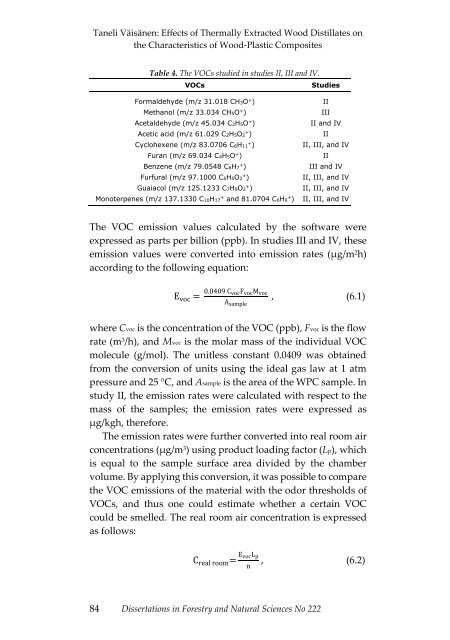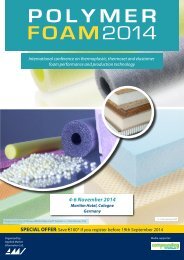Dissertations in Forestry and Natural Sciences
24lYKFN
24lYKFN
Create successful ePaper yourself
Turn your PDF publications into a flip-book with our unique Google optimized e-Paper software.
Taneli Väisänen: Effects of Thermally Extracted Wood Distillates on<br />
the Characteristics of Wood-Plastic Composites<br />
Table 4. The VOCs studied <strong>in</strong> studies II, III <strong>and</strong> IV.<br />
VOCs<br />
Studies<br />
Formaldehyde (m/z 31.018 CH3O + )<br />
Methanol (m/z 33.034 CH5O + )<br />
Acetaldehyde (m/z 45.034 C2H5O + )<br />
Acetic acid (m/z 61.029 C2H5O2 + )<br />
Cyclohexene (m/z 83.0706 C6H11 + )<br />
Furan (m/z 69.034 C4H5O + )<br />
Benzene (m/z 79.0548 C6H7 + )<br />
Furfural (m/z 97.1000 C5H5O2 + )<br />
Guaiacol (m/z 125.1233 C7H9O2 + )<br />
Monoterpenes (m/z 137.1330 C10H17 + <strong>and</strong> 81.0704 C6H9 + )<br />
II<br />
III<br />
II <strong>and</strong> IV<br />
II<br />
II, III, <strong>and</strong> IV<br />
II<br />
III <strong>and</strong> IV<br />
II, III, <strong>and</strong> IV<br />
II, III, <strong>and</strong> IV<br />
II, III, <strong>and</strong> IV<br />
The VOC emission values calculated by the software were<br />
expressed as parts per billion (ppb). In studies III <strong>and</strong> IV, these<br />
emission values were converted <strong>in</strong>to emission rates (µg/m 2 h)<br />
accord<strong>in</strong>g to the follow<strong>in</strong>g equation:<br />
E voc = 0.0409 C vocF voc M voc<br />
A sample<br />
, (6.1)<br />
where Cvoc is the concentration of the VOC (ppb), Fvoc is the flow<br />
rate (m 3 /h), <strong>and</strong> Mvoc is the molar mass of the <strong>in</strong>dividual VOC<br />
molecule (g/mol). The unitless constant 0.0409 was obta<strong>in</strong>ed<br />
from the conversion of units us<strong>in</strong>g the ideal gas law at 1 atm<br />
pressure <strong>and</strong> 25 °C, <strong>and</strong> Asample is the area of the WPC sample. In<br />
study II, the emission rates were calculated with respect to the<br />
mass of the samples; the emission rates were expressed as<br />
µg/kgh, therefore.<br />
The emission rates were further converted <strong>in</strong>to real room air<br />
concentrations (µg/m 3 ) us<strong>in</strong>g product load<strong>in</strong>g factor (Lp), which<br />
is equal to the sample surface area divided by the chamber<br />
volume. By apply<strong>in</strong>g this conversion, it was possible to compare<br />
the VOC emissions of the material with the odor thresholds of<br />
VOCs, <strong>and</strong> thus one could estimate whether a certa<strong>in</strong> VOC<br />
could be smelled. The real room air concentration is expressed<br />
as follows:<br />
C real room = E vocL p<br />
n<br />
, (6.2)<br />
84 <strong>Dissertations</strong> <strong>in</strong> <strong>Forestry</strong> <strong>and</strong> <strong>Natural</strong> <strong>Sciences</strong> No 222



